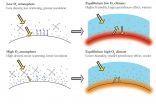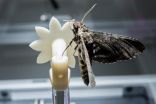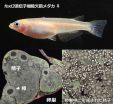(Press-News.org) ANN ARBOR--Variations in the amount of oxygen in Earth's atmosphere significantly altered global climate throughout the planet's history. Efforts to reconstruct past climates must include this previously overlooked factor, a new University of Michigan-led study concludes.
Oxygen currently comprises about 21 percent of Earth's atmosphere by volume but has varied between 10 percent and 35 percent over the past 541 million years.
In periods when oxygen levels declined, the resulting drop in atmospheric density led to increased surface evaporation, which in turn led to precipitation increases and warmer temperatures, according to University of Michigan paleoclimatologist Christopher Poulsen.
"The connection between oxygen levels and climate has never been considered. It turns out that it's an important factor over geological timescales," said Poulsen, a professor in the Department of Earth and Environmental Sciences. While not as critical to climate as levels of heat-trapping carbon dioxide gas, oxygen plays a key role, he said.
"Oxygen concentration can help explain features in the paleoclimate record not accounted for by variations in carbon dioxide levels, and it must considered if we are to fully understand past climates," Poulsen said. "However, variations in oxygen levels are not an important factor in present-day climate change."
The study is scheduled for online publication in the journal Science on June 11.
Throughout Earth's history, oxygen levels repeatedly rose and fell. Removing oxygen molecules thins the atmosphere, increasing the likelihood that incoming sunlight will make it to the surface without getting scattered away.
More sunlight means more evaporation from the surface, which leads to higher humidity levels and increased precipitation. As humidity levels rise, temperatures also increase because water vapor is a potent heat-trapping "greenhouse" gas.
Adding oxygen molecules has the opposite effect: a thicker atmosphere, more scattering of incoming sunlight, reduced surface evaporation, and less heat trapped by water vapor.
In their Science paper, Poulsen and two colleagues quantify the effect of changing oxygen levels on climate using an atmospheric global climate model to account for changes in atmospheric density, mass and molecular weights.
The team's computer simulations focused on the mid-Cretaceous, a period characterized by high atmospheric carbon dioxide levels and the warmest conditions of the last 100 million years. Specifically, they focused on Cenomanian Age, from 100.5 million years ago to 93.9 million years ago.
They developed a series of simulations in which oxygen levels varied from a low of 5 percent to a high of 35 percent. They found that decreased oxygen levels led to substantial increases in global precipitation rates and temperature.
Changing oxygen concentrations could help explain features of the paleoclimate record not accounted for by variations in carbon dioxide levels, such as warm polar temperatures and unexpectedly high precipitation rates in some periods, the researchers conclude.
Though previously unappreciated for its influence on climate, changing atmospheric oxygen levels have long been recognized for shaping the course of life on Earth. Billions of years ago, for example, photosynthesizing cyanobacteria in the oceans released massive amounts of oxygen that eventually made it possible for animals to colonize the land.
INFORMATION:
Co-authors of the Science paper are Clay Tabor of the U-M Department of Earth and Environmental Sciences in the College of Literature, Science, and the Arts, and Joseph D. White of Baylor University. The study was funded by grants from the National Science Foundation's Sedimentary Geology and Paleobiology Program and the agency's Marine Geology and Geophysics Program.
More info: U-M Earth and Environmental Sciences
This news release is available in Japanese.
Water injected into an inactive fault can cause aseismic slip along the fault -- movement without detectable earthquakes -- that may then indirectly lead to micro-earthquakes. That's the result from a controlled experiment by Yves Guglielmi and colleagues, who observed these events in real time after injecting fluid into a natural fault near an underground experimental facility in southeastern France. Researchers are intensely interested in this type of induced seismicity, especially with a rise in earthquakes caused by ...
This news release is available in Japanese. New experiments in the Japanese rice fish show that the fox13 gene appears to be the switch that determines whether a germ cell becomes an egg or sperm cell. The finding could help researchers learn more about how the sexual fate of germ cells is determined during vertebrate development. Toshiya Nishimura and colleagues demonstrated that fox13, which is expressed in germ cells but not in the surrounding cells of the fish's reproductive organs, provides a molecular cue that prevents the start of sperm formation. When the researchers ...
This news release is available in Japanese.
Variations in the percentage of atmospheric oxygen may have influenced climate in the past 500 million years, according to new calculations by Christopher Poulsen and colleagues. Since oxygen isn't a greenhouse gas like carbon dioxide, it typically hasn't been included in studies of past climate change. But the proportion of atmospheric oxygen has varied between 10 percent and 35 percent over the past 500 million years, and Poulsen and colleagues have developed a model to show how those fluctuations might impact climate. ...
This news release is available in Japanese.
How do nocturnal insects forage so successfully in the twilight and darkness? A new study by Simon Sponberg and colleagues suggests that the vision of the hawkmoth, Manduca sexta, which hovers in place while it feeds on nectar at dawn and dusk, is finely attuned to the swaying of flowers in the breeze. These findings imply that both the sight and flight of the hawkmoth likely evolved to match the movements of flowers -- their only source of food -- perfectly, helping to explain how the nimble insects are able ...
A new study by researchers at the Stanford University School of Medicine found that synchronized physiological interactions between remote brain regions have genetic underpinnings.
The research was performed at Stanford but was made possible by collaborations with the Seattle-based Allen Institute for Brain Science and the IMAGEN Consortium, a multicenter European project, said the study's senior author, Michael Greicius, M.D., an associate professor of neurology and neurological sciences.
The study will be published June 11 in Science.
An emerging consensus among ...
This news release is available in German.
It has been hypothesized that globalization of human-mediated dispersal of species may break down biogeographic boundaries. However, empirical tests had been lacking until recently. An international research team has now discovered a comprehensive biogeographic reorganization for 175 species of alien gastropods across 56 countries. The data shows that homogenization is indeed happening. Geographic barriers to dispersal have fallen down but climate still limits how species colonize new areas. The study was published in the ...
Investigators from Massachusetts General Hospital (MGH) and the Ragon Institute of MGH, MIT and Harvard have added another piece to the puzzle of how a small group of individuals known as elite controllers are able to control HIV infection without drug treatment. In their paper published in the open-access journal PLOS Pathogens, the research team reports finding that dendritic cells of elite controllers are better able to detect the presence of HIV - paradoxically through a greater susceptibility to HIV infection - which enables them to stimulate the generation of T cells ...
The concept sounds like the stuff of science fiction: take a pill, and suddenly new tissues grow to replace damaged ones.
Researchers at Case Western Reserve and UT Southwestern Medical Center this week announced that they have taken significant steps toward turning this once-improbable idea into a vivid reality. In a study published in the June 12 edition of Science, they detail how a new drug repaired damage to the colon, liver and bone marrow in animal models -- even going so far as to save the lives of mice who otherwise would have died in a bone marrow transplantation ...
This news release is available in Japanese.
Researchers in Japan have found, for the first time in vertebrates, a genetic switch that determines whether germ cells become sperm or eggs. The gene is named foxl3, and has been identified using a small fish called medaka (Oryzias latipes). In medaka without this gene's functionality, surprisingly, sperm are produced in the ovaries of females. The sperm that are produced function normally, and have been confirmed to produce normal offspring. These results will be announced in the journal Science through Science Express ...
EDMONTON, Canada, June 11 -- In this summer's much anticipated blockbuster Jurassic World, actor Chris Pratt joins forces with a pack of swift and lethal velociraptors. 'Velociraptor belongs to a group of predatory dinosaurs called the deinonychosaurs, or simply the 'raptors',' says University of Alberta paleontologist Scott Persons. 'Raptors are characterized by particularly nasty feet. Their big toes each bore an enlarged and wickedly hooked talon, which makes raptors well suited for Hollywood fight scenes.'
Persons and University of Alberta alumnus Lida Xing are part ...


